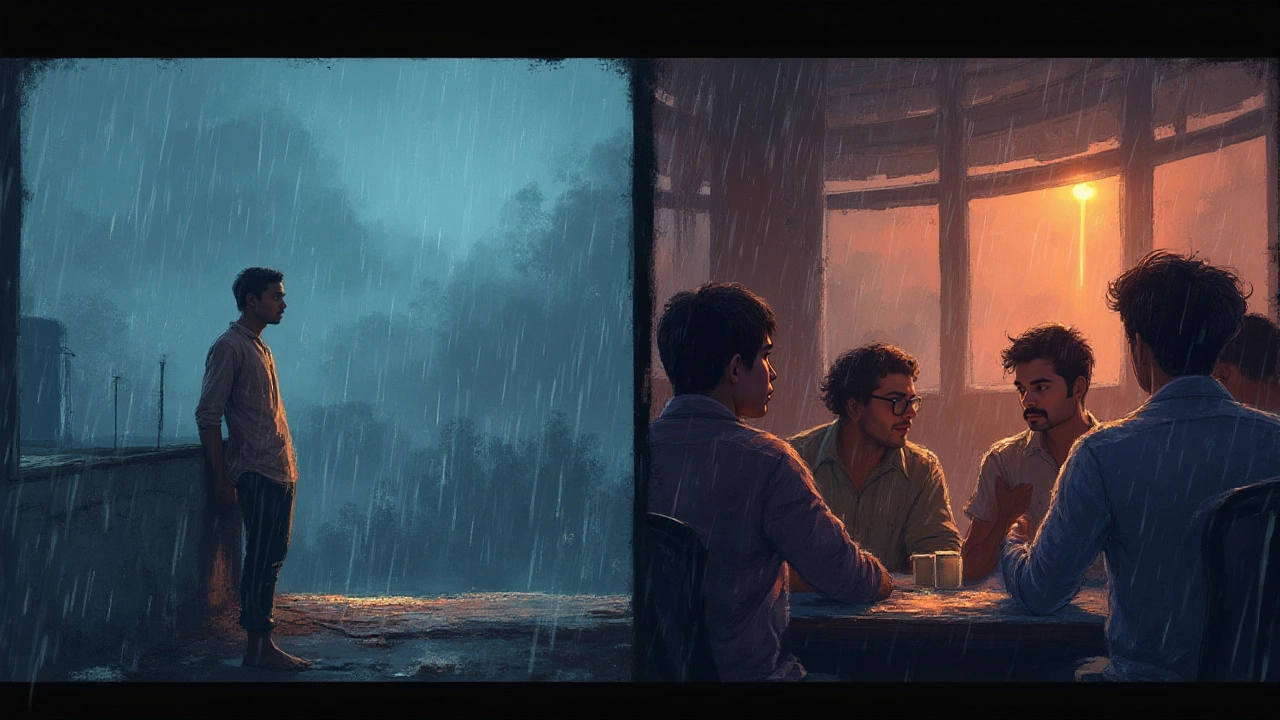Hardest Mental Illness to Live With: Understanding and Coping with Severe Psychiatric Disorders
 Jul, 5 2025
Jul, 5 2025
Ask ten different people what feels like the toughest mental illness and you’ll end up with ten emotional, wildly different answers. For some, the cruelest battle happens inside their own heads every single day, even when everything looks perfectly fine on the outside. Mental illness doesn’t always look the way we expect, and labeling any kind of emotional nightmare as “the hardest” is a massive call. Still, some psychiatric disorders make daily life so excruciating—so confusing and isolating—that it’s nearly impossible to measure exactly how much they steal from a person’s world. So, which mental illness wears the cruelest crown?
The Contenders: Why Some Illnesses Feel Tougher Than Others
Let’s cut straight to it. Among mental health professionals, schizophrenia often tops the list of the most overwhelming conditions. With hallucinations, delusions, chaotic thoughts, and drastic mood changes, it can hijack a person’s ability to function and interact with reality. But it’s not the only one that brings unimaginable struggle. Severe bipolar disorder, treatment-resistant depression, and borderline personality disorder (BPD) all get mentioned in the same breath when talking about pain and difficulty.
Picture this: You’re standing in the kitchen, trying to make breakfast, and suddenly you’re convinced someone is watching through the wall. Or you believe your neighbour has implanted thoughts in your head. This level of disconnectedness—classic in schizophrenia—makes ordinary life feel impossible. But again, those with crippling depression or disabling anxiety might say their battle is just as tormenting.
| Condition | Approximate Prevalence | Main Challenges |
|---|---|---|
| Schizophrenia | ~1% globally | Hallucinations, delusions, severe disconnection from reality |
| Treatment-resistant depression (TRD) | Up to 30% of depressed patients | Persistent, unrelenting sadness, hopelessness, suicidal risk |
| Bipolar Disorder (Severe) | ~1-2% | Drastic mood swings, impulsive behavior, high hospitalization rates |
| Obsessive-Compulsive Disorder (OCD) | ~2% | Intrusive thoughts, distressing compulsions, shame |
| Borderline Personality Disorder (BPD) | ~1-2% | Extreme emotional instability, self-harm, relationship chaos |
What makes one mental illness 'harder’ than another? Symptoms that sabotage basic thinking, break down relationships, get in the way of work or parenting, or even threaten survival tend to be considered among the most severe. Add shame, stigma, and the sense that nobody else could ever understand, and things get even heavier.
But let’s not forget: Hardship depends a lot on the person, their world, and their own support systems. Two people might both have schizophrenia but walk very different paths—one with stable treatment and caring support, the other isolated and struggling to access care. The label matters, but so does the story behind it.
Schizophrenia: When Reality Itself Crumbles
If you talk to psychiatrists about the hardest mental illness to live with, schizophrenia gets named time and again. It’s not just the frightening symptoms—like hearing voices or seeing things nobody else does—but the way it unravels your very sense of self and reality. Most people develop schizophrenia between late teens and early 30s. The symptoms often begin quietly: social withdrawal, odd beliefs, trouble organizing thoughts. By the time full-scale hallucinations or paranoid delusions appear, life can already feel upside-down.
The tough part? It’s not just the symptoms—medication side effects, repeated hospital visits, and years of stigma compound the pain. Many people with schizophrenia are unable to hold steady employment; social relationships may fall apart. Australia’s National Mental Health Commission notes that people with schizophrenia have a life expectancy 10-20 years shorter than the general population, mostly due to poor physical health and limited access to ongoing care.
The isolation is brutal. People with schizophrenia are misunderstood and stereotyped—painted as dangerous or “crazy”—even though violence is rare and most just want to fit in. The World Health Organization estimates that around 50% of people living with severe mental illness receive no treatment at all. Imagine that: needing help, but being too scared, ashamed or unable to reach out. This is the loneliness that defines the condition for many.
But here’s something hopeful: while schizophrenia is severe, treatment can help. Antipsychotic meds, therapy, supported housing, and family education all make a massive difference. Peer-support groups and community-based care break down that isolating wall by connecting people who get it. The real problem becomes access, discrimination, and chronic underfunding of mental health support—especially for those in rural or marginalized communities. In Melbourne, several grassroots initiatives are making slow but steady progress, but resources still trail far behind demand.
I’ll always remember meeting a local mum whose son developed schizophrenia at uni. She described the grief of “watching the person you knew slowly disappear”—but said the glimmers of connection, laughter, and ordinary moments now mean even more. Things are hard, maybe the hardest, but there’s still some light.

Bipolar Disorder and Treatment-Resistant Depression: Life’s Emotional Roller Coasters
While schizophrenia often leads the rankings for disruption, there’s a fierce argument for severe bipolar disorder and treatment-resistant depression as just as harrowing. Bipolar’s mood swings can rip apart jobs, friendships, marriages—even when everyone’s trying their best. One moment, someone feels on top of the universe, invincible (mania); the next, they’re in a black hole. According to Black Dog Institute, bipolar disorder is associated with a 15x higher suicide risk than the general population. That’s the real, relentless weight so many live with silently.
Treatment-resistant depression, meanwhile, means months or years of chronic, grinding sadness that defies medication, therapy, and time. No matter what you try, the fog won’t lift. Roughly 1 in 3 depression sufferers will experience some form of TRD, and even in 2025, treatment options can feel limited. When every morning feels the same—a chore, a letdown—life loses color and hope. TRD often brings terrible insomnia or exhaustion, wrenching guilt, and total apathy toward things you once loved, even your own kids.
This is the truth people don’t see in TV dramas about quirky or “creative” depressives. The chronic, invisible struggle isn’t poetic. It can be absolutely exhausting, isolating, and—if left untreated—deadly. People in this situation need understanding support and a relentless search for the right mix of therapies, whether it’s medication, cognitive behavioral therapy, electroconvulsive therapy (ECT), or newer options like ketamine infusions.
If you love someone with bipolar or TRD, stay patient and connected. Relapses will happen. But there is always room for improvement, especially when managed with the support of skilled mental health teams. Education and open communication are powerful tools. I teach my daughter Orla that sometimes feelings and moods get stuck, big-time—and even grown-ups need help to manage them.
Personality Disorders: The Struggle That Gets Ignored
BPD and other personality disorders don’t get the same media attention as schizophrenia or depression, but their impact deserves equal spotlight. Borderline Personality Disorder is famous among psychiatrists for its extreme emotional swings, problems with self-identity, and rocky relationships—often sabotaged by outbursts, desperate fear of abandonment, and cycles of self-harm or suicidal feelings.
About 1-2% of adults live with BPD. Symptoms usually show up in adolescence or early adulthood. On the surface, someone with BPD might seem impulsive or ‘dramatic’, but what’s really happening inside is a storm of pain and confusion. They often struggle to trust others or themselves. Arguments that feel trivial to outsiders can feel life-or-death to someone with BPD. Relationships often get strained to breaking point, and that’s if the person isn’t left completely isolated by friends and family who can’t take the volatility anymore.
The hardest part? Many with BPD, and other severe personality disorders, face barriers getting help. Stigma among health professionals is rampant—many are dismissed as manipulative or ‘untreatable.’ But recent research in Australia is proving that skills-based interventions, like Dialectical Behaviour Therapy (DBT), can help manage the pain. It turns out that, with real support and specialized therapy, even conditions once described as “incurable” can improve a great deal. People with BPD can and do get better, sometimes thriving in relationships and work with the right treatment.
Living with or loving someone with BPD is a challenge because progress isn’t linear. There will be setbacks. But hope and recovery should never be written off. Personal stories of recovery are powerful reminders: if you hang in there, breakthroughs are possible.

Life Hacks and Support: Handling Severe Mental Illness Day-to-Day
So what do you do if you or someone you love is dealing with a mental illness that feels, well, impossible? There’s no magic spell, but real-world tips do make a difference:
- Routine is your friend. A simple morning or night routine can create structure when everything else feels unpredictable. Even basic daily habits—like showering, eating regular meals, and getting outside—help the brain reset.
- Track symptoms and triggers. Mood and behavior journals work wonders. Apps like Moodpath or Daylio make this easier than ever, and data can help clinicians tweak treatment.
- Say yes to support—formal or informal. Peer support groups (in person or online) can be life-changing, even if you’re introverted. Just knowing someone else gets it is hugely validating.
- Celebrate every win. Even things that seem “small” to others—making a phone call, getting out of bed, attending an appointment—are massive victories. Give yourself genuine credit.
- Educate those around you. Most people still don’t know what schizophrenia really is, or how it affects those dealing with it. Gently informing family, teachers, or employers can make the path a bit less rocky.
- Build a crisis plan. It’s not fun to think about, but having a plan for what to do (and who to contact) when things spiral out of control can be a real lifesaver.
- Treat physical health as just as important as mental health. Movement, sleep hygiene, balanced eating, and regular checkups reduce the risk of complications like diabetes or heart disease, especially with antipsychotic medication.
In 2025, telehealth and digital mental health services have boomed in Australia. It’s now easier to access online psychiatry, therapy, and support from your own home, even if stigma or rural living get in the way. Resources like Beyond Blue and SANE Australia are leading the digital movement. Never underestimate the power of tiny steps—connection, journaling, meal prepping, scheduling “worry time”—to get a little bit of life back under your control.
If you’ve read this far, you know the hardest mental illnesses aren’t always obvious. They’re messy, personal, and make getting through each day a massive act of courage. People living with schizophrenia, bipolar, or severe depression aren’t weak—they’re some of the bravest folks you’ll ever meet. If someone opens up about their struggle, listen. It could be the most important thing you do all week.